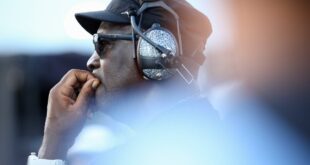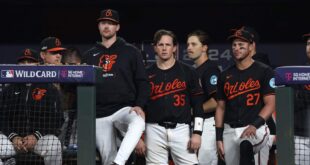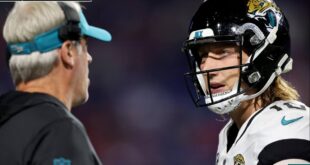Aaron Judge pounded the old-school scoreboard in left-center field with such ferocity that 18-year-old Luke Weaver feared for the safety of everyone.
Each time a ball struck the scoreboard, it echoed like a sonic boom, reverberating off the three poles that held it up. The Brewster Whitecaps’ stadium in the Cape Cod League is enveloped by dense trees on three sides, allowing the sound of a baseball striking metal repeatedly in the summer of 2012 to echo even 12 years later.
“You could hear it almost rocking,” New York Yankees reliever Luke Weaver said. “There was this feeling that if he kept hitting it, he would knock it over on one of them.”
Weaver and Judge were teammates in the Cape Cod League during the summer of 2012: Weaver, a freshman at Florida State, and Judge, a junior at Fresno State. At that time, Weaver generated more buzz than Judge; the wiry, unassuming athlete was one of FSU’s most celebrated signings. Meanwhile, Judge, standing 6-foot-7, naturally drew attention on any baseball field, his towering presence reminiscent of an NBA forward.
Now, Judge has established himself as MLB’s best hitter. Judge’s 218 wRC+ this season is the highest for a right-handed batter in MLB history. The Yankees’ superstar is a virtual lock to win his second American League MVP Award after leading the league in home runs (58), RBI (144), walks (133), on-base percentage (.458), slugging percentage (.701) and OPS (1.159). Judge’s slugging percentage alone ranked higher than 11 teams’ combined OPS this season.
In 2012, Judge wasn’t seen as a can’t-miss prospect; there were weaknesses in his game that opponents could exploit, primarily due to his size. At the time, Weaver had no inkling that they would both emerge as key figures on a World Series contender, standing in this position today.
“There wasn’t the kind of status around him that there is now,” Weaver said. “You’re sitting there thinking he’s got all the tools to be one of the best players. But if the media isn’t circulating around that player and hyping him up, you don’t really think about it more than it needs to be.”
Even when Judge debuted for the Yankees in 2016, his performance was lackluster. With a .609 OPS and a staggering 50 percent strikeout rate, he struggled to make an impact when the Yankees called him up that August, ushering in the Baby Bombers era.
However, that offseason altered the trajectory of his career.
In early November 2016, one of Judge’s agents, David Matranga, called Richard Schenck, a hitting instructor, to see if his client could work with him. Although Judge had the talent to make the majors that year, it was clear he needed to refine his swing to achieve his long-term goals.
Schenck met Judge at a D-BAT hitting facility in Peoria, Ariz., and spent a week with the Yankees prospect, hitting twice a day.
“I didn’t know who the heck he was when I was asked to work with him,” Schenck said. “I’m from St. Louis. I’m a Cardinals fan. I didn’t follow the Yankees or their draft picks.”
The first drill Schenck introduced to Judge was the command drill, in which he instructs hitters to get ready to swing. When he says “go,” they must swing. They’re then timed. The faster the better, because it emulates the speed at which pitchers are throwing the baseball. The goal of this drill is to ensure hitters are prepared to swing immediately when prompted, without loading or shifting in the box first. Judge attempted the drill but struggled.
“I put the ball on a tee for me and a ball on the tee for him. David said ‘Load up, go,’” Schenck said. “I was 62, Aaron was 24 and he could not hit the ball before me. That got his attention. He still talks about it to this day. He is way bigger, way better and way stronger and yet I hit the ball and squared it before him. That got his attention.
“His swing was terrible. He had an amateur swing. He was a good athlete but couldn’t get his barrel up to speed quickly. That’s what you need to do in order to hit. That’s what we worked on. Initially, I wasn’t impressed with his swing.”
Judge pushed back on his personal hitting coach’s assessment of his swing in 2016.
“I wouldn’t say it was terrible, but I just got done hitting .179 in the big leagues,” Judge said. “I didn’t want to do that again. If this is what got me .179, I think me making a change would hopefully get me better than .179. I was open to anything. It’s about taking a risk and taking a chance. If I was going to get out of this game and fail and never play again, I’d rather it be on my terms than anybody else’s.”
Before the 2017 season began, Judge and Schenck held 23 sessions, each lasting between 40 minutes to an hour. About halfway through their training, Schenck noticed significant progress in Judge’s swing. He observed that Judge was beginning to snap the barrel backward instead of pushing it forward, a fundamental principle of Schenck’s teaching. This adjustment leads to a powerful stretch between the snap of the barrel and a hitter’s rear leg, marking the point where their hard work began to translate onto the field.
“All of a sudden, you get this little smirk like holy s—, what did I just do?” Schenck said. “At that point, they’re hooked. It’s an addiction.”
In 2017, Judge hit 52 home runs and won the AL Rookie of the Year Award. Eight years after their initial meeting, Judge and Schenck now schedule hitting sessions every two weeks at a private facility, both at home and on the road. Occasionally, Judge cancels their sessions, feeling his swing is in such a good place that there isn’t much to work on.
That deep barrel, that ‘short to’ path…..is why their numbers are so much better than others. pic.twitter.com/kkjSNyYJAg
— Richard Schenck, JFD PPP LQC TTE 🙂 (@Teacherman1986) September 30, 2024
Even when the pair don’t meet, Schenck frequently sends video clips of himself discussing and demonstrating Judge’s swing, providing a visual of what his coach observes during his at-bats. He shares side-by-side comparisons of when Judge’s swing was nearly perfect and what he’s doing in the moments when he’s struggling at the plate. Judge has fully embraced Schenck’s hitting philosophy, where his mistakes are now so subtle that it can sometimes be nearly impossible to pinpoint what’s going wrong. Sometimes, it’s an issue of timing; other times, Judge struggles to maintain control in his launch position when he needs to decide whether to swing.
It’s during these moments of failure that Judge finds motivation. He often tells reporters that he doesn’t feel truly locked in at the plate unless he’s hitting 1.000 — a feat that is impossible throughout a season. No matter how well his numbers indicate he’s performing, Judge is always searching for improvement.
“Anything I did growing up, whether it was basketball or football, I wanted to be the best,” Judge said. “I probably got that from my dad, who always worked with me and always pushed me. He wanted perfection. He wanted the best for me. I think I took that trait from him.”
In recent years, Judge has sharpened his ability to detect even the slightest flaws in his swing. During their sessions in the batting cage, Schenck might praise his form, but Judge will often correct him, noting that he missed the barrel.
In 2022, as Judge approached the single-season American League home run record, he sensed something was amiss. He sent Schenck a video from his batting practice, believing his swing path was slightly off. Schenck confirmed that Judge’s intuition was spot on. The very next day, he hit his 62nd home run.
“He can feel things that I can’t see,” Schenck said. “He’s always been a perfectionist, but he’s just more perfect now than he was then.
“I don’t want to say the game is easy, but the game is easier for him than it is for everyone else.”
Inside the American League clubhouse at this year’s All-Star Game, Kansas City Royals shortstop Bobby Witt Jr. exchanged tips with Judge. The presumptive runner-up in the MVP race was struck by Judge’s remarkable ability to consistently be on time for any pitch, regardless of what’s coming.
“It’s incredible to see what he’s doing with how consistent he is,” Witt said. “That’s the biggest thing because a lot of times with power hitters, they go through things. But with him each and every week, he’s chucking away and putting up numbers to help his team win. This game comes down to how well you can prepare, the work you put in and the mindset. The game is evolving with the pitching and everything. It means you have to evolve. That’s what everyone is doing.”
Being ready to swing at pitch release gives Judge the maximum time to decide whether to unload or not. Judge’s mastery of his mechanics also allows him to be in position to hit regardless of whether the opposing pitcher is throwing 100 mph fastballs or 75 mph curveballs.
This year, Judge led MLB in run value against four-seam fastballs, sinkers and sweepers. Despite facing the highest volume of sweepers among all hitters, he slugged an astounding .816 against the frisbee-like slider. Over the past two seasons, opposing pitchers have frequently relied on sliders while attacking Judge, hoping he would chase pitches off the plate. This year, Judge faced the most sliders of his career, and he responded with a remarkable .984 OPS against all types of sliders.
Judge’s OPS, HRs against all pitches
| Pitch type | Total pitches | HR total | OPS |
|---|---|---|---|
|
Four-seamer |
771 |
17 |
1.246 |
|
Sinker |
488 |
12 |
1.282 |
|
Cutter |
253 |
4 |
1.077 |
|
Change-up |
303 |
6 |
.998 |
|
Splitter |
89 |
3 |
1.522 |
|
Curveball |
149 |
3 |
.969 |
|
Knuckle curve |
24 |
1 |
1.400 |
|
Slider |
520 |
5 |
.885 |
|
Sweeper |
273 |
7 |
1.240 |
Judge’s mechanics allows him to render any pitch type irrelevant when he’s in the batter’s box. Schenck noted that Judge has remarked that if he had practiced this technique as a teenager, he likely would have been the No. 1 overall pick.
“When you deeply understand this, it’s like you’re cheating,” Schenck said of his teaching. “It’s like you’re a varsity player on JV.”
For most of 2024, Judge resembled Bronx Little League legend Danny Almonte. It was as though Judge was playing a different game than everyone else. His 218 wRC+, the seventh-highest in MLB history, was 37 percentage points better than Shohei Ohtani’s 181. Judge’s 11.2 fWAR ranks as the 19th highest in MLB history, surpassed only by legends such as Babe Ruth, Barry Bonds, Lou Gehrig, Rogers Hornsby, Honus Wagner, Ted Williams, Ty Cobb, Pedro Martinez, Mickey Mantle, and Jimmie Foxx.
Even after smashing 62 homers in 2022, Judge leveled up in 2024. Beyond his home run total, he excelled in nearly every counting category this season.
“The best version we’ve ever seen,” Boston Red Sox manager Alex Cora said of Judge this year. “And he’s had some great seasons before, right?”
“I believe that Judge is the most amazing hitter that I’ve ever watched,” Yankees third baseman Jazz Chisholm Jr. said.
One of Judge’s primary objectives heading into the 2024 season was to improve his control of the strike zone, and he achieved that goal. He swung at fewer pitches outside the strike zone than ever before in his career. Aside from the shortened 2020 season, Judge also made contact with more pitches inside the strike zone than at any previous point.
Additionally, there has been a noticeable shift in his approach to each at-bat. Over the past three seasons, nearly half of his at-bats have ended in a fly ball — an ideal outcome given his strength. While he and Schenck didn’t alter his swing path, Judge noted that he is now focused on hitting line drives rather than simply elevating the ball.
“I try to hit it out toward the batter’s eye and hit it into our bullpen,” Judge said of his approach. “If I can hit a line drive out there and if I can get a little under it, it’s going to be a higher chance of a home run. I think it’s just some of the swing changes I made all the way back in ’17 about just kind of cleaning up my path a little bit to try to help me get the ball in the air more.
“I’m not really trying to hit home runs, which people think I do. I really don’t. I’m trying to hit line drives, and my line drives like (Giancarlo) Stanton, Yordan Alvarez and some of those guys, they just happen to go out.”
Judge led MLB with a 32.2 percent home run-to-fly ball ratio, surpassing any HR/FB ratio that Bonds achieved. As a lifelong fan of the San Francisco Giants, Judge has often cited Bonds as an influence and considers him the greatest player in MLB history.
What Schenck didn’t foresee when they first met in 2016 was that Judge would evolve into a right-handed version of Bonds. If a pitcher fails to execute their pitches, beware.
“You make a mistake, you’re getting a new ball,” Yankees manager Aaron Boone said.
Schenck doesn’t hold back his training secrets when working with Judge; he often posts videos of their sessions and the drills they perform. He feels validated when reviewing footage of players outside of his own clients, noting that regardless of who fans consider the best in the game, they all snap the barrel backward, consciously or not. In contrast, those who struggle typically fail to load properly.
While every player has a unique batting stance, Schenck asserts that the mechanics from load to contact are fundamentally the same. Some players execute these mechanics more consistently than others, but the best, including Judge, all share this common approach.

Judge (pictured in September 2016) struggled in his first month and a half in the majors. (AP Photo/Kathy Kmonicek)
In Schenck’s view, what truly sets Judge apart is the combination of his exceptional technique and athleticism.
“When Aaron decides to swing, he swings,” Schenck said. “When the ball comes at you at 100 mph or 78 mph, you can’t afford any slop moves. You have to just swing. You can’t move to a new position then swing after you’ve decided to swing. You have to be able to instantly swing.”
Judge was never worried about his rough start in April; he recognized it was merely a timing issue. He was healthy and making solid contact, but just a tick off. He knew that once his mechanics fell into sync, he would start delivering damage. With a .674 OPS in his first 123 plate appearances and only four home runs — just one more than Alex Verdugo — Judge appeared to be struggling. He then exploded for the rest of the season, hitting a home run every 8.48 at-bats.
But home run records aren’t what Judge is chasing; he wants a title. Judge has already accomplished every meaningful individual accolade a player can earn, but the glaring gap on his resume is a World Series championship.
Fair or not, Yankees greats are evaluated by the rings they possess. He could retire now and still be celebrated for the rest of time in Yankees lore like Don Mattingly, a former captain who never won a title. Mattingly was, and still is, a fan favorite, but he’s not in the same conversation as legends like Jeter, Rivera, Ruth, Gehrig, Mantle, DiMaggio and Berra.
Given how Judge’s career is trending and how he has mastered the art of hitting, a championship could firmly establish him in the pantheon of the most storied franchise in baseball.
“I think there’s no question he’s one of the franchise’s greatest players, but he’s playing for that,” Boone said. “That’s why he does this, not to rack up the personal accolades. He embodies that. He lives that. And that’s what we’re all working to get to. And I’m sure winning it all would certainly add a level to his legacy.”
(Top photo of Aaron Judge: Al Bello/Getty Images)
 meganwoolsey Home
meganwoolsey Home



